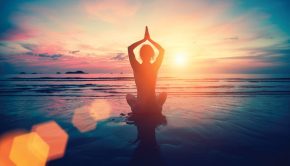CYCLES OF SPIN, Returning to its Heart-Healthy Origins
Like many newly minted sports, “Spin” has at its center a near-mythical figure: its creator, Jonathan Goldstein—better known as Johnny G—by most accounts a unique eccentric with an unheralded passion for cycling.
In 1987, while training for the renowned The Race Across America bike event, a mega-marathon 3,100-mile race from Los Angeles to New York, Goldstein was struck by a car and nearly killed. It produced an epiphany: Building an indoor bike simulating the outdoor experience would create a novel workout that would incorporate cardio training and emphasize a mind-body connection.
With the formation of Mad Dogg Athletics in 1994, the Spinning craze began rolling. Rolling Stone magazine named it the newest hot exercise and by 1996 there were 1,000-plus Spinning centers in 30 countries.
True to Form
Conceived as a form of cardio biofeedback, the activity keyed on training the heart muscle aerobically using a heart monitor. The original goal was to provide an “aerobic base” by working at 65 to 80 percent of one’s maximum heart rate, making the heart a more effective pump and increasing oxygen levels throughout the body.
The Spin program follows the principle that participants will train aerobically for six to 12 weeks prior to a “Race Day”—a special ride performed at a steady anaerobic threshold generally at 85 to 95 percent of maximum heart rate. Anaerobic threshold, or AT, is the point at which the body accumulates lactic acid in the muscles faster that it can be removed.
“Aerobic base building creates a strong foundation for increasing one’s lactate threshold,” explains Lorey Pro, a master Spin instructor and assistant director of fitness and wellness at Louisiana State University. “Riders can increase their tolerance for anaerobic exercise.”
“The metabolism’s foundation is strengthened by aerobic base building. Without it, the body will fall apart if the athlete moves right into anaerobic threshold training,” explains Shannon Derby, a master Spin instructor and certified group fitness and personal trainer at Mountain’s Edge Fitness Center, in Boulder, Colorado.
In contrast to indoor cycling, Spin requires that exertion rates be correlated to levels based on maximum heart rates, and revolutions per minute (RPMs) or pedal strokes be kept at pre-specified levels. According to Pro, Spin should combine mind and body training by using a variety of heart rate zones to improve health, fitness and performance.
Instructors take participants through a series of rides known as Energy Zones, each serving a specific purpose like endurance, strength or recovery. Terri Arends, a master Spin instructor and group fitness director at the Jewish Community Center of Dallas, Texas, attests that without such rides, the aerobic foundation crumbles. She likes to put riders through “kicking Spin rides and moments of Zen that allow riders to let go and find their inner athlete.”
Lost in Translation
In today’s typical Spin class, no one wears a heart monitor. While some gyms and boutique facilities offer endurance or strength rides, most conduct only interval rides featuring top 40 music selections and a loose interpretation of the prescribed movements, positions and cadence rates. “Interval rides tend to get picked most,” observes Derby. “There are many different kinds and they are fairly easy to teach and well liked, even though that isn’t what the official Spinning program recommends.”
Del Lugo, a Spin instructor and fitness professional in Suffern, New York, who works at the nearby Torne Valley Sports Complex and Lifeplex Health Club, says he rarely sees classic Spin done anymore. In Lugo’s world, Spin should be simply a “fun, safe experience with the instructor endeavoring to instill enthusiasm and encouragement.”
Moving Forward
One key indicator of whether a fitness activity is a trend and not a fad is the American College of Sports Medicine (ACSM) annual Fitness Trends survey. In 2012, Spin made ACSM’s top 20 list of fitness trends, citing it as “one of the most popular group exercise programs in the commercial sector.” Yet it fell off of ACSM’s list last year.
Reviving the original training program may prove helpful in preventing potential Spin burnout. Workouts were originally designed to culminate each week in a meditative, low-impact recovery ride to allow for rest and recovery, which is pivotal to any successful fitness program. The key to Spin’s continuity may be in moving cycling back to its origins—re-educating participants about how best to use Spinning to maximize desired results for body, mind and spirit.
Janet Osen is a freelance writer in Rockland County, NY. She is a certified Spin instructor currently working toward her 200-hour yoga teacher certification.
Latest Spins on Original Spin
Hydrorider: Lightweight aluminum, rust-proof bike affords aqua cycling in the pool.
RealRyder: Bike innovation tilts and moves with participants’ body weight to more accurately simulate outdoor cycling.
High Tech: Onboard computers track resistance levels, cadence and heart rates designed for precision rides.
Bands Classes: Resistance bands attach to a sliding track on the ceiling to tone abs, arms and chest.
Fusion: Classes combine Spin with other workouts like yoga.

<












